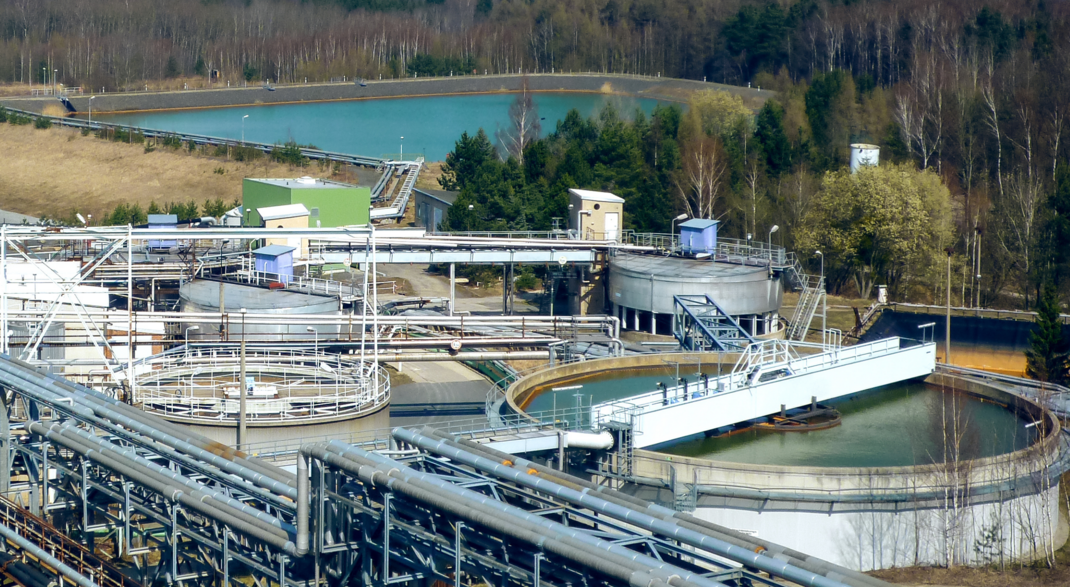The Königstein Wismut mine was unique in the world and, after the end of active uranium mining at the beginning of the 1990s, posed a major challenge in terms of remediation in general and in particular to avoid harmful effects on people and nature. At this site, Wismut extracted the uranium by chemical means in a mine excavation. The metal was "leached" from the mineralized sandstone blocks using a sulphuric acid solution, separated in a plant on the surface and processed into an intermediate product, which was originally sent for final processing at Wismut's Seelingstädt site in Thuringia.
In 1993 and 1994, Wismut commissioned the development of a remediation concept for Königstein: in a first phase in parallel to ANSTO (Australian Nuclear Science and Technology Organization) and UIT together with the US company NRT (Nuclear Remediation Technologies), in a second phase to UIT with ANSTO as subcontractor. The concept of controlled flooding of the pit was linked to the recommendation to separate the uranium contained in the flooding water, which temporarily had quite high concentrations, in a plant and to process it into a saleable product in order to avoid the dumping of a uranium-containing residue from the water treatment, which was necessary anyway, on the dump at the site. In 1995, UIT developed a special, innovative uranium technology for Wismut and confirmed it with extensive tests. The main process stages included
- Countercurrent sorption of uranium on an ion exchange resin (IX)<o:p></o:p>
- Fractionated elution for extensive separation of the uranium from the adsorbed iron (large-scale application of IX chromatography)<o:p></o:p>
- Separation of the remaining iron by means of continuous precipitation<o:p></o:p>
- Highly selective, continuous precipitation of uranium as peroxide (UO4 2H2O)<o:p></o:p>
- Separation of dissolved impurities through multi-stage product washing and dewatering<o:p></o:p>
Following a complex approval process, the old Königstein plant was converted to the new technology in 1997. The uranium extraction from the flooding water that was introduced proved to be highly efficient from the outset and met all the conditions for the remediation of the mine, especially during a phase with very high uranium concentrations in 2002 due to the remediation. The very lengthy flooding of the mine required the uranium separation plant to be operated until 2020. The plant, which has now been shut down, will be dismantled in the coming years. Parallel to uranium extraction as part of the remediation, UIT developed a new, highly efficient technology for further water treatment to separate numerous heavy metals and natural radionuclides (so-called HDS technology, but with multi-stage neutralization to improve the residual material properties for safe landfilling). UIT provided the complete planning services for this and took on the role of construction supervisor.
Construction and conversion had to take place while the old plants, which were required for the time being, remained in operation. With the mediation of the UIT, a contract was concluded in 1996 between Wismut and the US Nuclear Fuels Corporation (NFC) for the sale of the uranium concentrate by Wismut to NFC. According to the contract, NFC was obliged to utilize the purchased uranium exclusively for peaceful purposes, i.e. for energy production. Over the past 25 years, UIT has acted as coordinator for the execution of the contract on behalf of NFC, i.e. it has performed a variety of organizational tasks, supervised the loading into the tank containers from the concentrate silo with representative sampling and quantity determination, mediated during the transport campaigns between the special logistics company commissioned by NFC, the transport company, Wismut and the Czech company DIAMO, which further processed the uranium concentrate before it could be forwarded to nuclear fuel production. In the early years, the concentrate was delivered to ENUSA (E) and later to Comurhex (F) for further processing.
Thanks to the excellent cooperation between all parties involved, uranium deliveries have run smoothly over the past 25 years. Now the very last delivery campaign has been successfully completed. Uranium production in Germany is therefore finally history.

